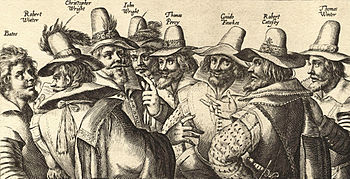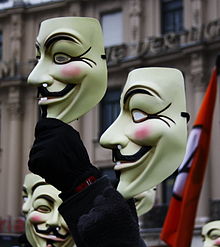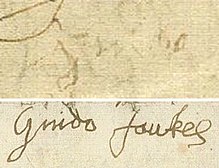Guy Fawkes

Guy Fawkes [ gaɪ fɔːks ] (born April 13, 1570 in York , † January 31, 1606 in London , also written Guido and Faux or Faukes ) was a Catholic officer of the Kingdom of England who on November 5, 1605 in London an explosives Attempted assassination attempt on King James I and the English parliament.
To commemorate the failure of the so-called Gunpowder Plot (German: "Gunpowder Conspiracy"), the Bonfire Night with traditional fireworks and torchlight parades is held every year in many places in England (especially by Anglicans ) .
Life
Guy Fawkes, the only son of Edward Fawkes and his wife Edith Blake, was born in a house on Stonegate in York and was baptized in St. Michael-le-Belfrey Church. After attending St. Peter's School, he converted to Catholicism at the age of 16 .
Fawkes served as a soldier for many years, gaining knowledge of handling explosives. In 1593 he was employed in the army of Archduke Albrecht VII of Habsburg in the Netherlands and fought there against the Protestants in the so-called Eighty Years War . In 1596 he was involved in the siege and capture of Calais . In 1602 he had the rank of ensign ; he had been recognized as a courageous and determined soldier.
Guy Fawkes, Robert Catesby and their co-conspirators attempted to blow up the English Parliament in the Palace of Westminster in London on November 5, 1605 . The reason for this was the persecution that members of the Catholic Church were exposed to. For the assassination he had already deposited 36 barrels with more than two tons of black powder in the cellars of the buildings (hence the English name Gunpowder Plot for the assassination), which he had rented for this purpose as storage space. Fawkes planned to kill King James I and his family, all members of parliament, all of the country's bishops and most of the high nobility with the attack on the opening day of Parliament in the House of Lords , as well as to free some political prisoners from the Tower of London . Then a Catholic king should be installed.
One of the co-conspirators wrote a warning letter to the Catholic Lord Monteagle , which he received on October 26th. Monteagle was advised to stay away from the opening of parliament. Instead of keeping this letter a secret, Monteagle passed it on to the authorities, headed by Robert Cecil , who is responsible for state security and the founder and head of the highly efficient intelligence service. The conspirators learned of the warning letter, but were not dissuaded from their plan after Fawkes assured them that the explosives had not been touched.
Guy Fawkes and the stored explosives were discovered by Justice of the Peace Thomas Knyvet on the morning of November 5th during an inspection of the cellars under Parliament. Fawkes brought to the Tower under torture confessed his planned crime and also named his co-conspirators, who were executed on January 30, 1606 by hanging, disembowelling and quartering . Guy Fawkes was also due to be executed a day later. He shortened the sentence by jumping off the gallows pedestal with the noose around his neck just before pulling up and breaking his neck.
Aftermath

"Bonfire Night"
In the UK , the attempt to prevent the attack is celebrated on November 5th each year under the name of “ Bonfire Night ”. In many places there are street parades or a torchlight procession in which a Guy Fawkes doll is burned and fireworks are lit. It is jokingly said in Britain that Guy Fawkes is the only man who ever went to Parliament with honest intentions.
Opening of Parliament
The annual opening of parliament traditionally begins to this day with the inspection of the cellars below the House of Lords by the Yeomen of the Guard .
Literature and protest culture
A nursery rhyme known in several variations, actually the first two verses of the first stanza of a song, recalls the event:
“Remember, remember
the Fifth of November
Gunpowder, treason and plot;
I see no reason
why gunpowder treason
Should ever be forgot. "
“Remember, remember
November 5th,
gunpowder, betrayal and conspiracy;
I see no reason
why the gunpowder betrayal should
ever be forgotten. "
Guy Fawkes was also listed at number 30 in the list of the “ 100 most important Britons ” in 2005 and has also remained lively in popular culture : British author Alan Moore and illustrator David Lloyd took up the character again in literary terms, as the protagonist of them successful dystopian graphic novel V for Vendetta (1982, filmed in 2005 ) disguised as Guy Fawkes.
The Guy Fawkes mask , designed by Lloyd, was first worn in 2007 by supporters of Republican presidential candidate Ron Paul and brought out into the public eye. The mask later also became a symbol of the Internet collective Anonymous and the Occupy Wall Street movement .
Even Ken Follett took advantage of the conspiracy, including the arrest of Guy Fawkes by Edmund Doubleday for his historical novel intelligence The foundation of eternity .
literature
- James Sharpe: Remember, remember, the fifth of November. Guy Fawkes and the gunpowder plot . Profile Books, London 2005, ISBN 1-86197-727-1
Web links
- Short biography of Guy Fawkes (www.spartacus.schoolnet.co.uk; English)
- Ronald D. Barley : On behalf of the Orthodox Terror in London . How a group of fanatical Catholics tried 400 years ago to blow up Parliament and its king. In: Die Zeit No. 45 . November 3, 2005, p. 90 ( zeit.de ).
Individual evidence
- ^ Digitized at Google Books , accessed on November 10, 2016
- ^ Matthias Heine: www.welt.de: Guy Fawkes - Why demonstrators wear an officer's mask ; Article in Die Welt on June 23, 2011; Retrieved October 20, 2011
- ↑ Konrad Lischka: grinning mask without a message . In: Spiegel Online from November 5, 2011
| personal data | |
|---|---|
| SURNAME | Fawkes, Guy |
| ALTERNATIVE NAMES | Fawkes, Guido; Faux, Guy; Faukes, Guy |
| BRIEF DESCRIPTION | Catholic assassin |
| DATE OF BIRTH | April 13, 1570 |
| PLACE OF BIRTH | York , Stonegate |
| DATE OF DEATH | January 31, 1606 |
| Place of death | London |
